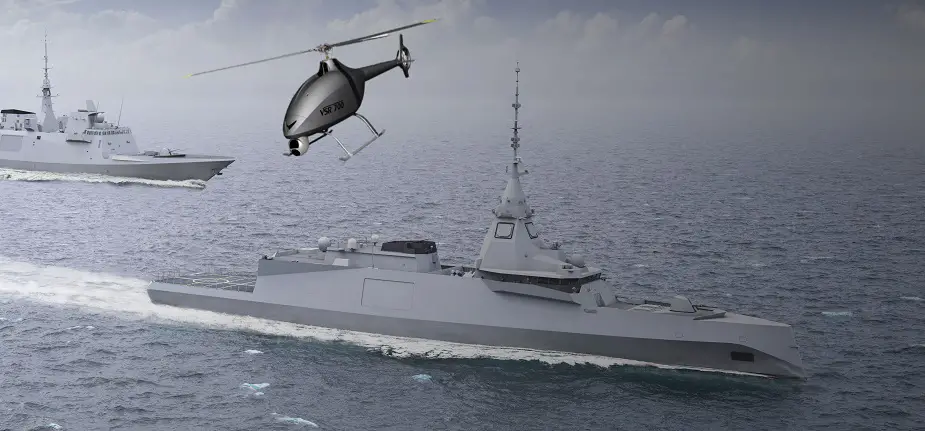Breaking news
Naval Group & Airbus Helicopters to Build VSR700 SDAM VTOL UAV Demonstrator.
The DGA (Direction Générale de l’Armement) has just awarded a contract for technology development in the field of rotary-wing drones to the Naval Group and Airbus Helicopters consortium. The contract covers de-risking studies ahead of construction of a future tactical helicopter drone demonstrator aboard warships. The demonstration project will lead to trials of the drone launch system, mission system and airborne vehicle, conducted from a French Navy vessel.

The purpose of the contract awarded by the DGA is to identify, deploy and test the technologies necessary for the integration of a tactical drone-system capacity within a heavily armed vessel. It forms part of the preparation of the SDAM (Navy Airborne Drone System), whose entry into service is foreseen for the middle of the next decade on new Intermediate-Size Frigates (FTIs) and other French Navy ships.
The study will help select the principal technologies for the SDAM and the identification of the technical risks necessary for initiating and realising the programme. The level of technological maturity sought is that of a demonstrator of the complete system in a representative environment.
Naval Group, European leader for naval defence, and Airbus Helicopters, the world’s leading producer of helicopters, will thus join their complementary competencies and know-how in the naval and aeronautic fields to prepare the French Navy’s future rotary-wing drone system.
The naval integration of aerial drones requires extensive experience of the technical and operational hurdles and the Navy’s missions in order to define robust and evolutive system architectures that help meet every need.
Naval Group and Airbus Helicopters shall be jointly responsible for the industrial project management and shall coordinate wider input from French industry/sector. To this end, Naval Group and Airbus Helicopters shall act as the programme design authority and shall have Hélicoptères GUIMBAL, Thales Systèmes Aéroportés, Safran E&S and ONERA as their principal subcontractors.
 VSR700 operating from an FTI. Naval Group CGI.
VSR700 operating from an FTI. Naval Group CGI.
Twelve years of experience in the naval integration of aerial drones
For Naval Group, drones exchange with the vessel’s combat system and their missions operated keeping in mind information from sensors and the tactical situation of reference from the combat management system. Representing a veritable tactical advantage, the drone forms an integral part of the warship, allowing increased operational potential for naval forces.
Hervé Guillou, President and CEO of Naval Group, indicates: “We are proud to have been selected by the DGA together with our long-standing partner Airbus Helicopters to allow the French Navy to integrate aerial drone systems into its units and strengthen its operational capabilities. This study also allows us to structure a world-leading industrial sector in this field. Naval Group thus confirms its capacity for innovation and technical mastery of naval systems and its role of whole warship architecture in the aero-naval domain.”
Naval Group has already started working on naval integration of aerial drone in 2005. The DGA gave him, between this date and today, several studies contracts that led to develop this technology (R&D contract IND, R&D contract D2AD, Serval).
VSR700, versatile and robust solution
Based on an innovative, versatile, robust and economical helicopter platform, the VSR700 drone system is being developed by Airbus Helicopters to offer its military clients the best possible combination of multi-role performance, reliability and operating costs. This 700-kg drone, derived from a light civilian helicopter, the Cabri G2, benefits from the technical know-how of Airbus Helicopters in certified autonomous flight systems and naval helicopters. A campaign of autonomous flights was started in June 2017 using an unmanned Cabri G2 prototype to validate the integration of the flight control systems and the vehicle’s new engine system, opening the way for the first flight of the VSR700 in 2018.
“I would like to thank the DGA and the French Navy for the trust they have placed in the VSR700 drone which, thanks to the combined experience of Airbus Helicopters and Naval Group, is expected to play a crucial role in the aero-maritime operation theatres of tomorrow” declared Guillaume Faury, CEO of Airbus Helicopters.
The VSR700 can exceed 10 flight hours of operational autonomy with a payload capacity of up to 150 kg, offering performance levels that have, until now, been the reserve of aircraft of a significantly higher category and size. The system will benefit from all the know-how of Airbus Helicopters in terms of automated flight control (the guarantee of a unique automatic deck-landing capacity in rough seas), autonomous navigation system, secure data link, the integration of sensors such as radar and optronic systems, the management of complex mission systems and the certification of military aircraft. This expertise, which builds on a heritage going back more than 70 years, allows Airbus Helicopters to design a drone system that precisely meets the needs of the French Navy.
The aerial vehicle has low maintenance requirements and strong synergies with the ships existing logistical footprint, thus limiting support and operations costs, while its compact size is compatible with the simultaneous use of an on-board helicopter across different surface ships.




























